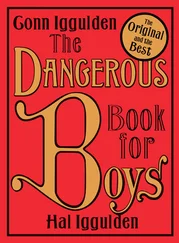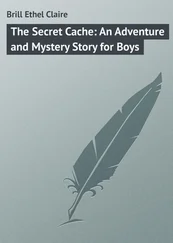Robert Robert - Scouting for Boys
Здесь есть возможность читать онлайн «Robert Robert - Scouting for Boys» весь текст электронной книги совершенно бесплатно (целиком полную версию без сокращений). В некоторых случаях можно слушать аудио, скачать через торрент в формате fb2 и присутствует краткое содержание. Жанр: Старинная литература, und. Описание произведения, (предисловие) а так же отзывы посетителей доступны на портале библиотеки ЛибКат.
- Название:Scouting for Boys
- Автор:
- Жанр:
- Год:неизвестен
- ISBN:нет данных
- Рейтинг книги:3 / 5. Голосов: 1
-
Избранное:Добавить в избранное
- Отзывы:
-
Ваша оценка:
- 60
- 1
- 2
- 3
- 4
- 5
Scouting for Boys: краткое содержание, описание и аннотация
Предлагаем к чтению аннотацию, описание, краткое содержание или предисловие (зависит от того, что написал сам автор книги «Scouting for Boys»). Если вы не нашли необходимую информацию о книге — напишите в комментариях, мы постараемся отыскать её.
Scouting for Boys — читать онлайн бесплатно полную книгу (весь текст) целиком
Ниже представлен текст книги, разбитый по страницам. Система сохранения места последней прочитанной страницы, позволяет с удобством читать онлайн бесплатно книгу «Scouting for Boys», без необходимости каждый раз заново искать на чём Вы остановились. Поставьте закладку, и сможете в любой момент перейти на страницу, на которой закончили чтение.
Интервал:
Закладка:
direction again. A man’s inclination somehow is to keep edging to his right, and the consequence is that when you think you are going straight, you are really not doing so at all. Unless you watch the sun, or your compass, or your landmarks, you are very apt to find yourself going round in a big circle.
In such a case a “tenderfoot”, when he suddenly finds he has lost his bearings, at once loses his head and gets excited. He probably begins to run, when the right thing to do is to force yourself to keep cool and give yourself something useful to do—that is, to track your own footprints back again; or, if you fail in this, to collect firewood for making signal fires to direct those who will be looking for you.
The main point is not to get lost in the first instance.
Notice the Directions
When you start out for a walk or on patrolling, note the direction, by the compass. Also notice which direction the wind is blowing; this is a great help, especially if you have no compass, or if the sun is not shining.
Every old scout notices which way the wind is blowing when he turns out in the morning.
To find the way the wind is blowing when there is only very light air, throw up little bits of dry grass. Or hold up a handful of light dust and let it fall. Or wet your thumb and let the wind blow on it; the cold side of it will then tell you from which direction the wind comes.
Using Landmarks
Then you should notice all important landmarks for finding your way.
In the country the landmarks may be hills or prominent towers, steeples, curious trees, rocks, gates, mounds, bridges— any points, in fact, by which you could find your way back again, or by which you could instruct someone else to follow the same route. If you remember your landmarks going out you can always find your way back by them; but you should take care occasionally to look back at them after passing them, so that you can recognize them for your return journey.
The same holds good when you arrive in a strange town by train. The moment you step out from the station notice where the sun is, or which way the smoke is blowing. Also notice your landmarks—which is this case would be prominent buildings, churches, factory chimneys, names of streets and shops—so that when you have gone down several streets you can turn round an d find your way back to the station without difficulty. It is wonderfully easy when you have practised it a little, yet many people get lost when they have turned a few corners in a town they do not know.
Concentrate on Your Job
When you are acting as scout or guide for a party, move ahead of it and fix your whole attention and all your thoughts on what you are doing. You have to go by the very smallest signs, and if you talk and think of other things you are very apt to miss them. Old scouts generally are very silent people, from this habit of fixing their attention on the work in hand.
Very often a “tenderfoot” out for the first time will think that the leading scout looks lonely and will go up to walk or ride alongside of him and begin a conversation—until the scout shows by his manner or otherwise that he does not want the ‘‘tenderfoot” there.
On small steamers you may see a notice, “Don’t speak to the man at the wheel”. The same thing applies to a scout who is guiding a party.
Using a Compass
I am certain that you know that the needle of a compass has the habit of swinging round until it points in one definite direction.
If you followed the direction indicated by one end of the needle you would come out at a spot north of Canada, about 1400 miles from the North Pole. The reason for this is that at this spot there is a powerful magnetic force. It is this force which attracts the north point of the needle and
makes it point to “Magnetic North”.
North is only one of the compass points. Every sailor knows the other points of the compass by heart, and so should a Scout. I have talked a
good deal about north, but that is only because we usually figure north as a starting point. That is just for convenience—we could just as well use south.
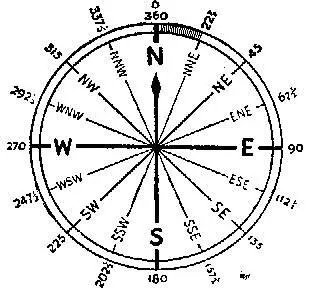
Explorers seldom refer to compass points. They use compass degrees instead because they are more exact.
When you look at the compass chart you will notice that it is marked not only with the points, but also with figures running clockwise from 0
at the north point round to north again which also has the figure 360. So any point can be given either as a compass name or as a degree number. Thus, east is 90 degrees, south is 180, west is 270, and so on. Instead of saying S.E. we can say 135 degrees.
How a Compass Helped My Career
Knowing the right way to use a compass helped to give me a good start in my army career.
It was this way:
With a number of other young officers I was being tested in surveying. We had to take a reading with our compass to a certain spot, and from there to another point, and from there to a third point. If one did it correctly, this last reading should land us exactly at the spot whence we started.
But it means extreme care to take an accurate reading. If you misread your compass’ by not much more than a hair’s breadth you would fail. Only one of our party had been exact enough to succeed, and who do think that was?
Little me!
As a result of this and a few good marks in other subjects, I got promoted with extra pay, with which I was able to buy the best horse I ever had.
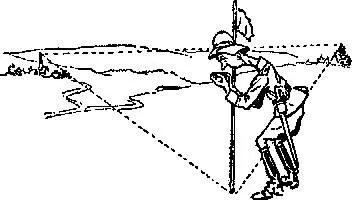
Compass work means extreme care to take an accurate reading
Finding the North without a Compass
Besides the “Magnetic North” which you find with your compass, there is the other north of the North Pole at the top of the earth. This
is the real north and for that reason is named “True North”.
North by the Sun
If you have no compass to show you “Magnetic North”, the sun will tell you by day where “True North” is, and from that you can figure out the other directions.
At six o’clock in the morning (standard time) the sun is east. At nine he is south-east. At noon he is south. At three o’clock in the afternoon he is south-west, and at six o’clock he is west. In winter he will have set before six o’clock, but he will not have reached west when he is set. This
applies roughly in the Northern Hemisphere. (In the Southern Hemisphere, at six o’clock the sun is east, at nine north-east, at noon north, at three north-west, at six west.)
The Phoenicians who sailed round Africa in ancient times noticed that when they started the sun rose on their left-hand side—they were going south. Then they reported they came to a strange country where the sun rose in the wrong quarter, namely on their right hand. The truth was that
they had gone round the Cape of Good Hope, and were headed north again, up the east side of
Africa.
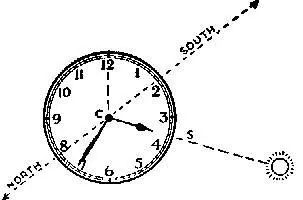
When the sun is out, a watch will help you find your direction
To find the south at any time of day by the sun, hold your watch flat, face upwards, so that the sun shines on it. Turn it round till the hour hand points at the sun. Without moving the watch, lay a pencil or stick across the face of the watch so that it rests on the centre of the dial and points out half-way between the figure XII and the hour hand. The direction in which it points is south. This applies only in the Northern Hemisphere. (In the Southern Hemisphere turn the XII, instead of the hand, to the sun, and south will then lie between the two as before.)
Читать дальшеИнтервал:
Закладка:
Похожие книги на «Scouting for Boys»
Представляем Вашему вниманию похожие книги на «Scouting for Boys» списком для выбора. Мы отобрали схожую по названию и смыслу литературу в надежде предоставить читателям больше вариантов отыскать новые, интересные, ещё непрочитанные произведения.
Обсуждение, отзывы о книге «Scouting for Boys» и просто собственные мнения читателей. Оставьте ваши комментарии, напишите, что Вы думаете о произведении, его смысле или главных героях. Укажите что конкретно понравилось, а что нет, и почему Вы так считаете.

![Роберт Баден-Пауэлл - Искусство скаута-разведчика[Scouting for boys ; Искусство Разведки для мальчиков]](/books/70572/robert-baden-pauell-iskusstvo-skauta-thumb.webp)



